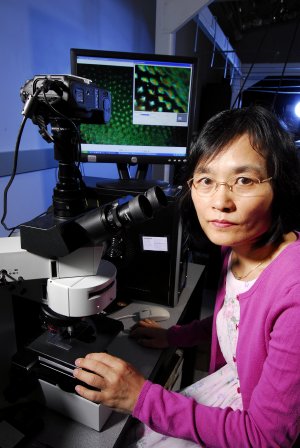Jul 24 2009
A small green beetle may have some interesting lessons to teach scientists about optics and liquid crystals - complex mechanisms the insect uses to create a shell so strikingly beautiful that for centuries it was used in jewelry.
 Georgia Tech Researcher Jung Ok Park uses a microspectrophotometer to image the exocuticle of a jewel beetle. Georgia Tech Photo: Gary Meek
Georgia Tech Researcher Jung Ok Park uses a microspectrophotometer to image the exocuticle of a jewel beetle. Georgia Tech Photo: Gary Meek
In an article to be published in the July 24 issue of the journal Science, researchers provide a detailed analysis of how a jewel beetle (Chrysina gloriosa) creates the striking colors using a unique helical structure that reflects light of two specific colors - and of only one polarization: left circular polarization. The reflecting structures used by the beetle consist predominately of three different polygonal shapes whose percentages vary with the curvature of the insect’s shell.
“Iridescent beetles, butterflies, certain sea organisms and many birds derive their unique colors from the interaction of light with physical structures on their external surfaces,” said Mohan Srinivasarao, a professor in the School of Polymer, Textile and Fiber Engineering at the Georgia Institute of Technology. “Understanding how these structures give rise to the stunning colors we see in nature could benefit the quest for miniature optical devices and photonics.”
With support from the National Science Foundation, Srinivasarao and colleagues Vivek Sharma, Matija Crne and Jung Ok Park used two different microscopy techniques to study the surface structures on the shell of the beetle. What they found confirmed earlier suggestions that the colors are produced from liquid crystalline material, which self-assembles into a complex arrangement of polygonal shapes each less than 10 microns in size.
“When we looked at the beetle’s surface, we found tiles in the shapes mostly of hexagons, pentagons and heptagons,” Srinivasarao said. “These patterns arise, we think, because of the nature of the cholesteric liquid crystal and how the liquid crystal phase structures itself at the interface between air and fluid. We think these patterns result because the liquid crystal must have defects on the surface when exposed to air, and those defects create the patterns in the beetle’s shell or exoskeleton.”
Because of simple geometric restrictions, the percentage of each shape depends on the curvature of that particular section of the shell. “This is really a pattern formation issue,” said Srinivasarao. “It is difficult to pack only hexagons onto a curved surface. On flat surfaces, there are fewer defects in the form of five- and seven-sided cells.”
In addition, the five- and seven-sided cells normally appear in pairs, an issue also dictated by the geometric difficulties of packing the shapes onto curved surfaces. The researchers found very similar structures in the ten different beetles purchased from an insect supply house.
Liquid crystalline materials are valuable industrially, used in displays for laptop computers, portable music players and other devices. They are also used in children’s thermometers, where temperature affects the color of light reflected from the material, indicating whether or not a child has a fever.
While the structures are determined genetically, their final form depends on the living conditions the beetle experiences during its growth and development, Srinivasarao noted.
The fact that these jewel beetles reflect circular polarization was identified in the early 1900s by a Nobel Prize-winning physicist, A.A. Michelson, who hypothesized that the circular polarization might result from a “screw structure” within the insect’s cuticle, but he did not elaborate on it further. The solidified structures produced from a cholesteric liquid crystal and its defects on the beetle’s shell reflect bright green light with a wavelength of 530 nanometers mixed with yellow light in a wavelength of 580 nanometers.
“The most dramatic way to get saturated color is through what this beetle does with the circularly-polarized light,” Srinivasarao said. “The reflection is very metallic and angle-dependent, and this is due to the helical pitch of the cholesteric liquid crystal.”
Sunlight normally contains light in equal quantities with a left circular polarization and a right circular polarization. The jewel beetle’s exoskeleton, however, reflects only light with a left circular polarization.
How the beetles benefit from the specific color and polarization isn’t known for sure, but scientists speculate that the optical properties may confuse predators, causing them to misjudge the location of the insects - or suggest that they may not be good to eat. The colors may also help the insects find mates.
In future research, Srinivasarao hopes to study other insects that use complex structures to create unique colors. He believes that scientists still have a lot to learn by studying the optical structures of beetles and other insects.
“We are just now starting to catch up with what these beetles have been doing for many, many years,” he said. “There are hundreds of thousand of species, and the way they generate color is just stunning - especially since it is all done with water-based systems, mostly based on the biopolymer chitin. This is self-assembly at several levels, and we need to learn a lot more to duplicate what these insects do.”